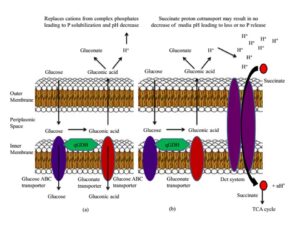
 A patent titled ?A depot formulation and process of preparation thereof? is granted to Dr Priti Mehta, Professor, Institute of Pharmacy and, Dr Tejaskumar Dadhaniya, ex PhD scholar at Institute of Pharmacy, Nirma University on Feb 17, 2021.
A patent titled ?A depot formulation and process of preparation thereof? is granted to Dr Priti Mehta, Professor, Institute of Pharmacy and, Dr Tejaskumar Dadhaniya, ex PhD scholar at Institute of Pharmacy, Nirma University on Feb 17, 2021.
Constitutive glucose dehydrogenase contributes to the phosphate solubilisation ability of rhizobia


Ms Bhagya Iyer
PhD scholar at Institute of Science, Nirma University
The 20th century Green Revolution helped in improving crop production by increasing the use of chemical inputs. This had led to exceptional gains in global food production. The addition of chemicals to the soil as fertilisers, herbicides and pesticides improved plant productivity, but it came with high environmental costs. The repeated use of chemical phosphate fertilisers affected the quality of food, led to an increase in cost and was detrimental to the environment. Hence, there was an urgent need for “Bio-Revolution” to reduce the harmful impact on the environment by employing microbe-based fertilisers.
A plant growing under field conditions is under the influence of a well-structured and regulated community of microorganisms. This microbial community (microbiome) associated with the plants assist them in challenges such as access to food nutrients, stressful conditions and harmful pathogens. The best-characterised association is the association of nitrogen-fixing rhizobia with the roots. The plants exert considerable control on the composition of the root microbiome through mechanisms like production of root exudates of various compositions and signal molecules. This section will recruit only specific types of bacteria. In the early 21st century, interest began to grow around the development of bio fertilisers as a means to reduce the number of fertilisers required for crop production, to minimise pollution, soil infertility and to reduce costs.
All plants need nitrogen for their growth. However, the plants cannot directly use the nitrogen (N2) present in the atmosphere. Nitrogen fixation is the foremost mechanism that augments the plant growth. Similarly, soil phosphorus and phosphates applied as fertilisers, is mostly unavailable to the crops as they form complexes with soil mineral. The Phosphate Solubilising Bacteria (PSB) can aid in enhancing uptake of phosphate by plants and improve plant phosphate nutrition. The general mechanism of the mineral phosphate solubilisation by the PSBs is the production and release of low molecular weight organic acids. However, the numbers of PSBs occurring in the soil are not high enough to compete with other microorganisms commonly established in the rhizosphere. So, the existing bio-fertilisers have at least two kinds of bacteria, a N fixer and a P solubiliser with synergistic activity.
Ms Bhagya Iyer carried out the doctoral research in this area under the supervision of Dr Shalini Rajkumar, Professor, Institute of Science, Nirma University. The current study was initiated with an aim to use a single class of bacteria, preferably rhizobia as an agent for both N fixation and P solubilisation. The main goal of the study was to determine the effect of such bacteria on plant growth under laboratory and soil conditions. The study was extrapolated to identify the mechanism of P solubilisation by both the rhizobia and its regulation by components of plant root exudates.
The study identified two rhizobia with dual properties of N fixation and P solubilisation with multiple plant beneficial traits. The ability of two rhizobia in influencing the growth of legumes was investigated and it was found to be highly significant even in highly alkaline soils. The mechanism of P solubilisation (which was not yet understood in rhizobia) was elucidated for both the rhizobial isolates and validated using expression studies, enzyme activity studies and HPLC analysis. The effect of the major root exudate component, the C4 acid succinate on the mechanism of P solubilisation was also studied. A novel mechanism by which the C4 acid succinate regulated P solubilisation in both the rhizobia was identified and validated. Genes responsible for numerous other plant beneficial traits were identified using genome sequencing approaches. The study hence identified multi-trait plant beneficial rhizobia for use as components of future bio-fertiliser formulations.
The outcomes of the study will be highly helpful in understanding the mechanism of P solubilisation in other rhizobia and related bacteria. The influence of rhizobia on the growth of legume plants under controlled (laboratory) and field (soil) conditions may help study the long-term benefit of the use of such bacteria for plant growth promotion and in improving soil nutrition. Such potential bacteria with multiple plant beneficial traits may be studied further in great detail to make it a beneficial component of the bio-fertiliser formulation.